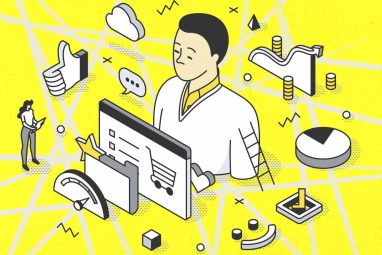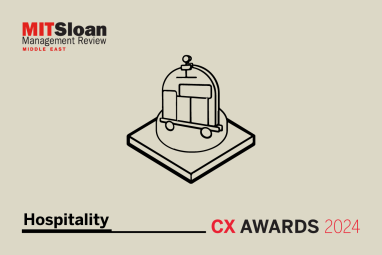Seven Reasons to Strengthen Your Customer Benefits Focus
When marketers focus on products instead of benefits, they may get blindsided by new rivals or miss new product opportunities. Are you truly putting benefits first?
Topics
News
- Gulf Nations Fast-Track AI Ambitions, UAE Leads Regional Readiness, says BCG Report
- AI Professionals form a Redefined Workforce. But Systemic Roadblocks Persist, Survey Finds
- AI-Driven Scams Surge as Microsoft Blocks $4 Billion in Fraud Attempts
- Identity-based Attacks Account for 60% of Leading Cyber Threats, Report Finds
- CERN and Pure Storage Partner to Power Data Innovation in High-Energy Physics
- CyberArk Launches New Machine Identity Security Platform to Protect Cloud Workloads

Neil Webb/Ikon Images
Harvard Business School professor Theodore Leavitt emphasized the customer impact of benefits when he famously argued that people don’t want to buy a quarter-inch drill; they want a quarter-inch hole.1 Although his idea is straightforward, many companies still fail to appreciate how embracing a benefits-driven approach can help them unlock new opportunities — for innovation, customer satisfaction, and sustainable growth.
Benefits are the desirable outcomes that customers receive from your brand. This definition holds true regardless of whether customers are in B2B or B2C spaces and whether the organization is a company, nonprofit, or sole proprietor offering a product, a service, or an experience. Benefits help customers reach their goals and reduce their pains.
Focusing on the benefits customers genuinely want offers a straightforward path for companies to design, market, and deliver their products and services, and to grow strategically in ways that resonate deeply with their target customers. For marketing executives, this path is also highly actionable: A focus on customer benefits lets a company examine its entire set of strategic decisions (market segmentation, target segment selection, positioning, company analysis, competitor analysis, implementation decisions, and growth opportunities) through the lens of benefits.
Why Marketers Must Put Customer Benefits First
As we note in our book, The Brand Benefits Playbook, some marketing leaders don’t tap into the power of a benefits-first perspective because they don’t understand the value of applying it in an integrated way.2 Here are seven compelling reasons why customer benefits should be a central concern of your company.
1. To avoid marketing myopia. Marketing myopia happens when organizations focus on a product, industry, vertical, or demographic instead of the benefits that customers want. For example, Coca-Cola wisely says its purpose is to “refresh the world.” By saying that it’s in the refreshment business (a benefits focus) rather than the soda business (a product focus), it opens a broader view of the potential market and the competitors in that market.
Here’s another example. The online search industry (for example, Google) emphasizes the search, which is an activity. Why do you search? To get the benefit of access to information. As we’ll discuss in a minute, ChatGPT provides exactly that benefit. If search companies don’t focus on the threat from new GenAI rivals that provide the same benefit, they could get hurt.
When we had a client that made software to control train traffic, we asked whether the company was in the train industry or the transportation industry. Trains are products; transportation is a benefit. If you think these are minor distinctions, consider the classic example of the buggy whip industry, which got wiped out in part because it didn’t think of itself as being in the transportation business. Companies that regularly look to understand the benefits their customers want and that are willing to reexamine their business practices are less likely to get blindsided by market evolution.
2. To identify potential competitors. A benefits perspective also helps organizations recognize potential competitors. Like most home insurance companies, Allstate offers people the benefit of feeling safe at home. Ring, which manufactures home security products like doorbells that record video, promotes the same benefit. The global doorbell camera market has grown due to concerns about security, safety, and the well-being of individuals and families. Could Allstate compete directly with Ring by providing a smart doorbell?
Focusing on customer benefits changes your perspective on where prospective competitors might come from, especially with regard to the threat of new entrants and the threat of substitute products, which Michael Porter describes in his classic book on competition.3
3. To see paths to growth. A benefits perspective helps companies grow by extending a given benefit to a new product category or providing different types of benefits. Consider Arm & Hammer as an example of the former. Originally a brand of baking soda, the product’s deodorizing benefit allowed Arm & Hammer to extend into all kinds of products for which deodorizing is important: kitty litter, car air fresheners, baby changing pads, air purifiers, diaper bags and pails, carpet cleaners, toothpaste, body wash, foot care, and more. The deodorizing benefit has also led to alliances with Dutch Boy (interior paint) and Hefty (trash bags). In short, being a brand known for a particular benefit enables growth opportunities beyond the product’s original focus.
Deodorizing ability is a functional benefit. Functional benefits provide solutions to problems so that customers feel that they have the efficacy to control their environments. Examples of functional benefits include reliability and durability (saving time and money, reducing stress, and providing a sense of control), convenience (saving time and making product use easy), protection or safety (providing security and control), and information (providing knowledge and efficacy). Organizations can grow by providing additional functional benefits or higher levels of existing benefits relative to competitors.
However, customers also value experiential and symbolic benefits. Experiential benefits engage customers’ senses, minds, and hearts, inducing feelings such as excitement, sensory pleasure, engagement, relaxation, or awe. Symbolic benefits enhance people’s feelings of belonging, status, or connectedness, or that they’re acting in a values-congruent way; Patagonia elicits such feelings when it appeals to consumers’ desires to support sustainability and environmental protection. When customers use brands that offer such benefits, it makes them feel inspired, proud, unique, and validated.
Many companies, if they focus on benefits at all, emphasize functional benefits and give short shrift to experiential and symbolic benefits. Has your organization fallen into this trap?
4. To develop new products. A benefits focus also facilitates new product development. When ChatGPT took off in the mainstream market in November 2023, the benefits were not new. Natural language processing and artificial intelligence technologies had been around for years, in products like Apple’s Siri and Amazon’s Alexa, for example. However, ChatGPT launched with a website that promoted the functional benefits of ease of use, increased productivity, and humanlike interaction. Unfortunately, the industry has some work to do around the potential symbolic benefit of social responsibility, which many people are demanding. According to results from the Edelman 2024 Trust Barometer survey, of those Americans who are unenthusiastic about the increasing prevalence of AI, the majority are concerned about its potential harm to society and people. The industry could reduce these concerns by addressing issues around social responsibility.
When the iPhone came out, it offered reliable phone service like its main competitor, BlackBerry. Apple overpowered the BlackBerry by focusing on benefits that customers wanted and then adding features and attributes that supported those benefits. Among them were providing a pleasing visual design in the product and the stores (an experiential benefit), technology that was easy to learn and use (a functional benefit), and a focus on status and coolness (a symbolic benefit). Of course, the benefit of compatibility with all of the apps in the Apple ecosystem (another functional benefit) helped as well.
5. To understand shocks and trends. Shocks are events that can affect what benefits customers want or how important existing benefits are to them. Shocks are like earthquakes: They send out tremors that rattle the status quo. For example, shocks from the COVID-19 pandemic made some previously unimportant benefits more critical. Consider the benefit of fast delivery: Companies like Amazon were well positioned to provide that service when it increased in importance. Conversely, restaurants were caught off guard as the benefits of convenience (having meals delivered at home) and safety (having curbside and contactless pickup) became more important to customers. Some restaurants were able to respond to these needed benefits and were able to survive; others were not.
6. To help companies financially. When companies offer the functional, experiential, and symbolic benefits that customers want, customers are more likely to become loyal to the brand and advocate on its behalf. Such customer behaviors, in turn, reduce costs and build revenue. It costs less to offer a brand to which customers are already loyal. It also costs less when customers advertise on a brand’s behalf through positive word of mouth. If the brand they want is out of stock, they will defer their purchase until it’s available.4
7. To help develop core competencies. Focusing on customer benefits is also consistent with work on an organization’s core competencies. Core competencies assist an organization in distinguishing its brands from those of its competitors and reducing costs more than competitors do, thereby attaining a competitive advantage. As Gary Hamel argued in his seminal article on this topic, one crucial test of an organization’s core competencies is that it “makes a significant contribution to the perceived customer benefits of the end product.”5
Key Questions to Ask About a Customer Benefits Focus
For all of these reasons, a benefits-focused perspective should be paramount in marketing and management decision-making. A benefits focus provides a lens for how to unlock growth, position brands in competitive environments, and communicate with customers during all interactions — whether they’re searching for information or reading a customer loyalty email.
Here are some key questions your organization should consider regarding its customer benefits perspective:
- Does your company focus on customers and the benefits they want in both its strategic decisions (segmentation, targeting, and positioning) and its tactical marketing decisions (marketing communications across all touch points with customers)?
- Has your company identified which benefits are critical and will drive customer decision-making, delight, and loyalty, thus helping your company financially?
- Have you considered what industries might serve as competitors (substitutes or new entrants) based on the benefits delivered
- How will enhancing the level of the benefits your brand offers, or adding new benefits (functional, experiential, or symbolic) strategically benefit your brand from competitive and growth standpoints?
We believe that companies have an inherent desire to be customer focused. The best way to really focus on customers is to focus on the benefits they seek.
References
1. T. Levitt, “Marketing Myopia,” Harvard Business Review 38, no. 4 (July-August 1960): 45-56.
2. A. Weiss and D.J. MacInnis, “The Brand Benefits Playbook: Why Customers Aren’t Buying What You’re Selling — and What to Do About It” (Dallas: BenBella Books, 2024).
3. M.E. Porter, “Competitive Advantage: Creating and Sustaining Superior Performance” (New York: Free Press, 1985).
4. C.W. Park, D.J. MacInnis, and A.B. Eisingerich, “Brand Admiration: Building a Business People Love” (Hoboken, New Jersey: John Wiley & Sons, 2016).
5. C.K. Prahalad and G. Hamel, “The Core Competence of the Corporation,” Harvard Business Review 68, no. 3 (May-June 1990): 79-91.





